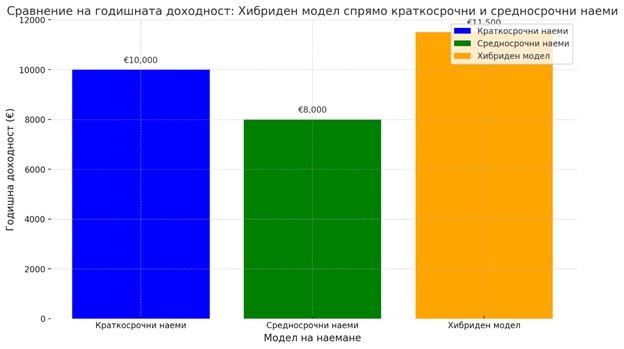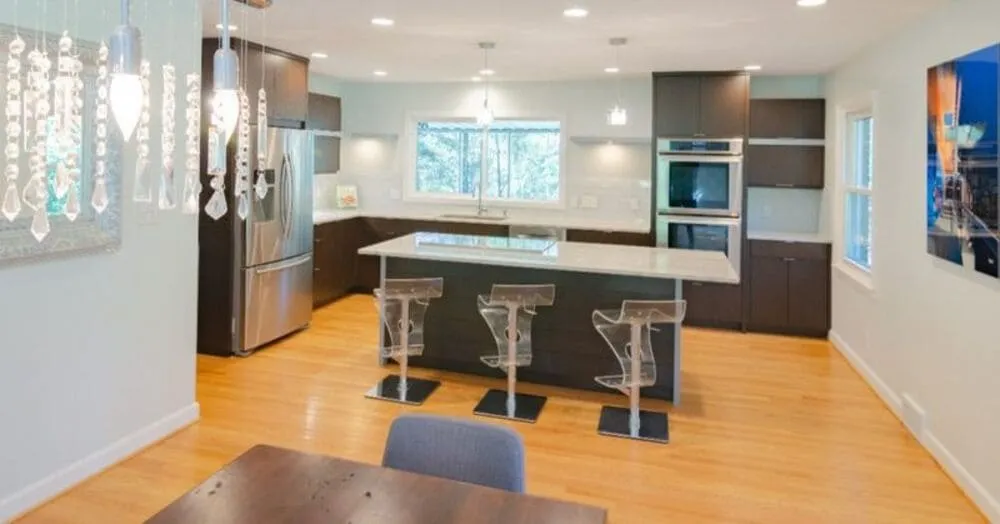Property owners today have more opportunities than ever to profit from rentals, thanks to the growing popularity of short- and medium-term rentals. Platforms like Airbnb and Booking.com attract tourists for short stays, while medium-term rentals (1-6 months) meet the needs of digital nomads and corporate employees looking for temporary housing. According to Secondnature.com, the demand for medium-term rentals is growing globally, especially in cities like Sofia, where business travelers and remote workers are increasingly common. But many owners are hesitant: short-term rentals promise high incomes but come with the risk of empty periods, while medium-term rentals offer stability but lower rates. The solution? A hybrid model that combines both approaches to maximize profits and minimize risks. Through strategic planning, owners can take advantage of peak tourist seasons and secure stable income the rest of the time. Read on to learn how to optimize your income with the hybrid model and turn your property into a reliable source of profit!
What are short-term and medium-term rentals?
Short-term rentals, typically lasting 1 to 30 days, are popular with travelers and vacationers booking through platforms like Airbnb and Booking.com. According to Lodgify.com, they offer high returns due to higher nightly rates, but require active management, including frequent cleaning and communication with guests. Medium-term rentals, lasting 1 to 6 months, appeal to digital nomads, business travelers, or temporary movers. Secondnature.com highlights their stability and lower depreciation properties, as longer stays reduce wear and tear. The target audiences differ significantly: short-term rentals cater to those looking for short vacations, while medium-term rentals cater to the needs of professionals or businesses. For example, an apartment in Sofia could be rented out short-term in the summer to tourists attending festivals, and medium-term in the winter to corporate employees on temporary projects. Understanding these models is the key to optimizing income through their balance.
Table: Comparison of short-term and medium-term rentals

Advantages of the hybrid rental model
The hybrid model, combining short-term and medium-term rentals, is a powerful tool for property owners looking to increase their profits and reduce risks. It combines the high yield of short-term rentals with the stability of medium-term rentals, offering flexibility and sustainability.
One of the main advantages is maximizing incomeAs already made clear, short-term rentals have high prices per night, especially during peak seasons. Medium-term rentals provide a steady cash flow. According to Geeklymedia.com, the hybrid approach can increased annual yield by up to 20%, as owners benefit from high prices during busy months and stable income during the rest of the time. For example, an apartment in Sofia can generate significant income from tourists in the summer and be rented out to a corporate employee in the winter.
Another advantage is flexibility. Owners can adapt their calendar to seasonal trends. In Bansko, short-term rentals thrive during the winter ski season, while medium-term rentals attract digital nomads in the summer. This adaptability is key to maintaining high occupancy.
Reducing empty periods is also a significant benefit. Medium-term rentals fill the gaps between tourist seasons, ensuring occupancy during periods of low demand. This reduces the risk of unoccupied months. For example, an apartment in Varna can be rented short-term in the summer and medium-term to remote workers in the fall, reaching close to 95% annual employment.
Finally, the hybrid model brings customer diversity, attracting tourists, digital nomads and businesses. This reduces dependence on one market segment, increasing sustainability. Diversification strengthens the business. In Plovdiv, a property can serve tourists on weekends and corporate clients for longer periods.
The hybrid model offers a clear path to higher profits, but it requires strategy. The next section will look at the challenges and how to overcome them.

Challenges in combining short-term and medium-term rentals
The hybrid rental model offers significant benefits, but it comes with challenges that require careful management. Transparency about these challenges is key for landlords considering this approach.
One of the main challenges is complexity in management. Short-term rentals require frequent communication with guests, cleaning coordination, and quick problem resolution, which can be time-consuming. Medium-term rentals, on the other hand, involve drafting contracts, tenant screenings, and longer-term maintenance. Managing both models simultaneously can take significant time and effort, especially for inexperienced owners. This is where we come in from Flat Manager with our many years of experience in property management.
Seasonal fluctuations are also a factor. Demand varies by location – for example, seaside resorts like Varna and Burgas are busy in the summer but quieter in the winter, which makes it difficult to plan rentals. Owners need to balance short-term bookings in peak seasons with medium-term contracts in the slower periods.
Furnishing and maintenance represent an additional challenge. The property must meet the needs of both tourists (e.g. amenities like a coffee machine) and medium-term tenants (e.g. fast Wi-Fi and workspace for digital nomads). This may require additional investment and regular maintenance.
Professional services can alleviate these difficulties. For example, at Flat Manager, we take on tasks such as marketing, reservations, cleaning and contracts, using digital platforms for transparency. Owners often tell us that professional management makes the transition between short-term and medium-term rentals easier, saving them time and effort. With the right approach, these challenges can be overcome, unlocking the full potential of the hybrid model.

How to Balance Short and Medium Term Rentals: Practical Tips
To succeed with a hybrid rental model, you need to plan carefully and adapt your strategy to market conditions. Here are five practical steps that will help you balance short-term and medium-term rentals for maximum profit.
Analyze the market. Start by researching local trends. For example, Sofia has year-round demand from business travelers, while the Black Sea coast attracts tourists in the summer. It’s a good idea to study seasonal fluctuations and guest demographics. Look at data from Airbnb or local travel agencies to understand when demand for short-term rentals is highest and when medium-term rentals can fill the gaps.
Optimize the calendar. Plan short-term rentals for peak seasons, such as summer for Varna or winter for Bansko, when tourists are most numerous. For quieter months, book medium-term rentals for digital nomads or corporate clients. For example, an apartment in Burgas can be rented short-term in July and August, and medium-term from September to May, ensuring high occupancy.
Use dynamic pricing. Prices should reflect demand. Adjusting rates according to the season or local events can increase revenue. For example, increase prices for short-term rentals during festivals in Plovdiv and offer competitive monthly rates for medium-term renters during the winter.
Furnish the property universally. The property should appeal to both vacationers and mid-term renters. Provide fast Wi-Fi and a workspace for digital nomads, as well as kitchen appliances and amenities like a coffee maker for short-term guests. Secondnature.com notes that universal furnishings reduce the need for frequent repairs, saving costs.
Trust professionals. Managing a hybrid model can be complicated, but professional services make the process easier. Companies like Flat Manager take care of listings on Airbnb and Booking.com, mid-term rental agreements, cleaning, and maintenance. For example, our owner-occupier client in Burgas increased his revenue by 30% after switching to a hybrid model with professional management, thanks to optimized calendaring and pricing.
With these steps, you can turn your property into a stable source of income, taking advantage of the best of both models.



